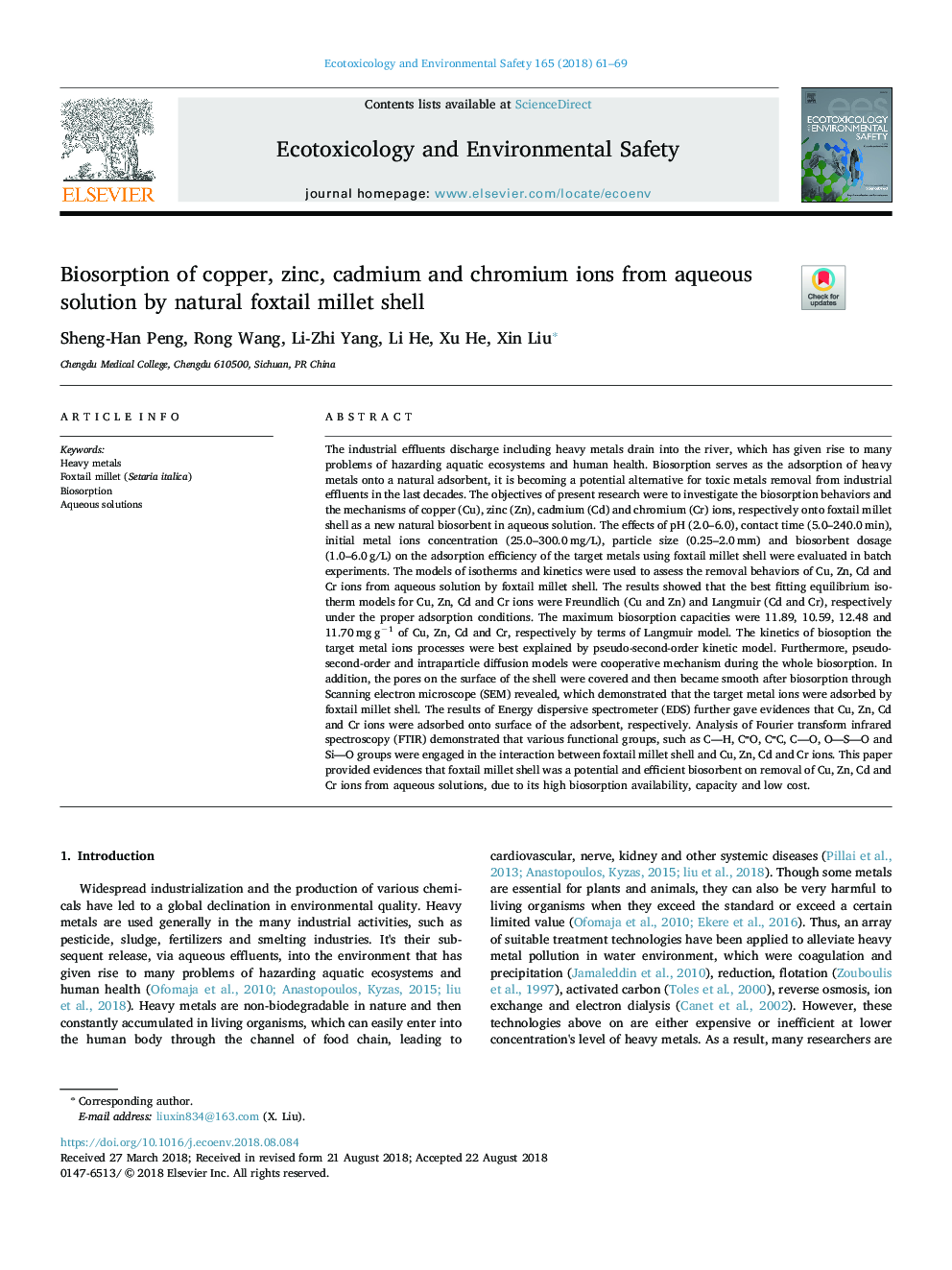| کد مقاله | کد نشریه | سال انتشار | مقاله انگلیسی | نسخه تمام متن |
|---|---|---|---|---|
| 10144499 | 1646303 | 2018 | 9 صفحه PDF | دانلود رایگان |
عنوان انگلیسی مقاله ISI
Biosorption of copper, zinc, cadmium and chromium ions from aqueous solution by natural foxtail millet shell
ترجمه فارسی عنوان
جذب یون های مس، روی، کادمیم و کروم از محلول های آبی با پوسته پروانه ی فلفل یونجه
دانلود مقاله + سفارش ترجمه
دانلود مقاله ISI انگلیسی
رایگان برای ایرانیان
موضوعات مرتبط
علوم زیستی و بیوفناوری
علوم محیط زیست
شیمی زیست محیطی
چکیده انگلیسی
The industrial effluents discharge including heavy metals drain into the river, which has given rise to many problems of hazarding aquatic ecosystems and human health. Biosorption serves as the adsorption of heavy metals onto a natural adsorbent, it is becoming a potential alternative for toxic metals removal from industrial effluents in the last decades. The objectives of present research were to investigate the biosorption behaviors and the mechanisms of copper (Cu), zinc (Zn), cadmium (Cd) and chromium (Cr) ions, respectively onto foxtail millet shell as a new natural biosorbent in aqueous solution. The effects of pH (2.0-6.0), contact time (5.0-240.0â¯min), initial metal ions concentration (25.0-300.0â¯mg/L), particle size (0.25-2.0â¯mm) and biosorbent dosage (1.0-6.0â¯g/L) on the adsorption efficiency of the target metals using foxtail millet shell were evaluated in batch experiments. The models of isotherms and kinetics were used to assess the removal behaviors of Cu, Zn, Cd and Cr ions from aqueous solution by foxtail millet shell. The results showed that the best fitting equilibrium isotherm models for Cu, Zn, Cd and Cr ions were Freundlich (Cu and Zn) and Langmuir (Cd and Cr), respectively under the proper adsorption conditions. The maximum biosorption capacities were 11.89, 10.59, 12.48 and 11.70â¯mgâ¯gâ1 of Cu, Zn, Cd and Cr, respectively by terms of Langmuir model. The kinetics of biosoption the target metal ions processes were best explained by pseudo-second-order kinetic model. Furthermore, pseudo-second-order and intraparticle diffusion models were cooperative mechanism during the whole biosorption. In addition, the pores on the surface of the shell were covered and then became smooth after biosorption through Scanning electron microscope (SEM) revealed, which demonstrated that the target metal ions were adsorbed by foxtail millet shell. The results of Energy dispersive spectrometer (EDS) further gave evidences that Cu, Zn, Cd and Cr ions were adsorbed onto surface of the adsorbent, respectively. Analysis of Fourier transform infrared spectroscopy (FTIR) demonstrated that various functional groups, such as C-H, CËO, CËC, C-O, O-S-O and Si-O groups were engaged in the interaction between foxtail millet shell and Cu, Zn, Cd and Cr ions. This paper provided evidences that foxtail millet shell was a potential and efficient biosorbent on removal of Cu, Zn, Cd and Cr ions from aqueous solutions, due to its high biosorption availability, capacity and low cost.
ناشر
Database: Elsevier - ScienceDirect (ساینس دایرکت)
Journal: Ecotoxicology and Environmental Safety - Volume 165, 15 December 2018, Pages 61-69
Journal: Ecotoxicology and Environmental Safety - Volume 165, 15 December 2018, Pages 61-69
نویسندگان
Sheng-Han Peng, Rong Wang, Li-Zhi Yang, Li He, Xu He, Xin Liu,
